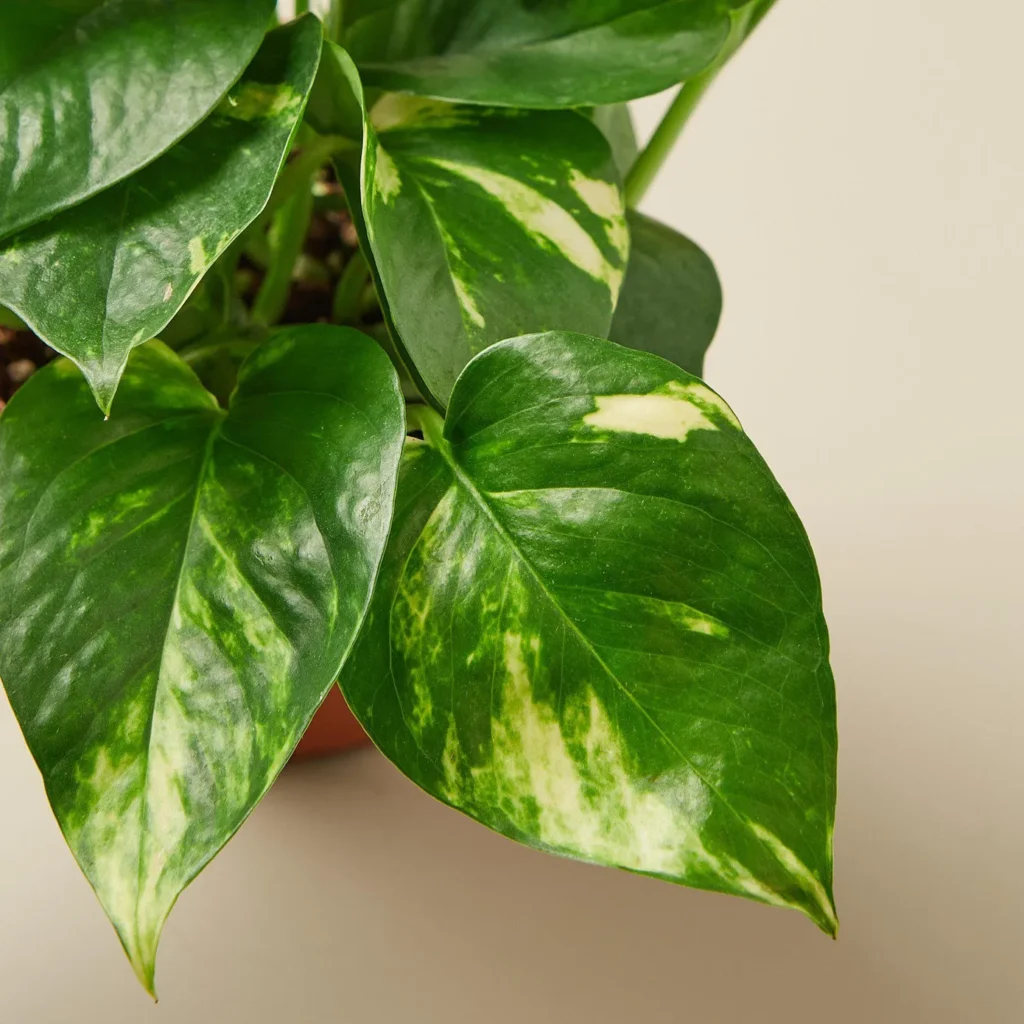Money Plant Care
Pothos plants are known for their ease of care and durability. They are happy placed in a bright well-lit area, however, they can tolerate lower light. They are living air purifiers, removing common household toxins from the air, making it a healthy and beautiful addition for your space.

How to care for your Money Tree
- LIGHT
Your Pothos prefers indirect bright light. It can tolerate lower light, but growth will slow and the colors may fade. Direct light can scorch the leaves.
- WATER
Water when 50-75% of the soil volume is dry. Water until liquid flows through the drainage hole at the bottom of the pot and discard any water that has accumulated in the saucer.
- HUMIDITY
This plant does well in average household humidity but appreciates an occasional boost of humidity. Try adding a pebble tray, grouping it with other plants, or placing a humidifier nearby.
- TEMPERATURE
Your plant prefers temperatures between 65°-85°F. Avoid cold drafty areas and open vents.
- FOOD
Feed once a month in the spring and summer with general-purpose houseplant fertilizer diluted to half-strength. Never apply fertilizer to dry soil.
- TOXICITY
Your Pothos is considered toxic to humans and pets if ingested.
- ADDITIONAL CARE
Trim out any dead, discolored, or damaged leaves and stems as they occur with clean, sharp scissors. Snipping stems just above a leaf node will encourage bushy and fuller growth. Stems that are removed can be easily propagated in water.
Common Issues for your Money Tree
Moisture
The most common cause of yellowing leaves among Pothos plants is improper soil moisture–in particular, overwatering. Only water your Pothos when the top 25% of the soil in the pot is dry. Soil should remain damp, but not wet or soggy. In the winter, you can allow your plant to dry out a little more between waterings, but be sure to boost the humidity around your plant with regular misting, a humidifier, or pebble tray.
When you water your Pothos, make sure you provide enough water so that liquid flows from the drainage hole at the bottom of the pot and into the saucer. It’s extremely important to discard any excess water in the saucer and not to let your plant sit in any standing water. Your Pothos will not respond well to “wet feet,” which will cause the roots to rot and lead to the eventual death of the plant.
Providing proper and consistent soil moisture is important in caring for a Pothos. Alternating between bone dry and wet soil from ill-timed waterings can create stress and cause the leaves of your Pothos to yellow.
Your humidity level
Low humidity and dry soil cause leaves to droop and brown on their edges, later followed by entire yellowing, browning, and leaf drop. Misting the leaves of your Pothos often will increase the humidity.
Improper Light
Pothos will grow best when placed in bright to medium indirect sunlight, but they will adapt to lower light if needed. However, if placed in very low light, yellow leaves may develop. Be careful you’re not placing your Pothos in full sun–when exposed to direct sunlight for too long, the foliage will burn.
Pests
A weakened or stressed Pothos is more susceptible to insect infestations. Sap-sucking bugs like spider mites can drain your plant of moisture. This problem quickly manifests itself by yellowing leaflets and fronds. Scale, mealybugs, and spider mites occur frequently in indoor conditions. If not killed early on, these small pests proliferate and move all along frond parts into nooks and crannies. The piercing mouths of the insects exhaust your plant and accelerate yellowing, especially if your Pothos is already unhealthy from poor lighting, a nutrient deficiency or improper soil moisture.
Some yellowing is natural
Is your Pothos pushing out new growth? If there is new growth on your plant and the yellowing leaves are older, particularly at the bottom of the plant, this yellowing is natural. Your plant sheds its old leaves and sends energy to new growth.
Incredibly dry soil
Your Pothos prefers soil that is consistently moist. Be sure you’re not over or underwatering your plant. Keep a consistent watering schedule–water when the top 2”-3” of the soil are dry.
If you accidentally let your plant’s soil dry out completely, you may see leaves go limp, droop, and possibly start to brown. If the soil is extremely dry all the way through the pot, a thorough soak is in order.
Here’s how to soak-water your Pothos:
- Place your plant in your sink or tub without the saucer. Fill your basin up with about 3-4″ of water. Make sure the water isn’t hot!
- Allow your plant to soak up water through the drainage hole in the bottom of the pot for at least 45 min.
- Feel the top of the soil after your plant has been soaking–has the water reached the top 2-3” of soil?
- If not all the soil feels saturated, water your Pothos slightly from the top of the soil to help speed up the saturation.
- When your plant’s soil is evenly damp, drain the sink/tub and allow the plant to rest while it drains thoroughly. Place the plant back on its saucer and back in its proper spot.
Not enough humidity
Your Pothos will thrive in a more humid environment. Increase the humidity around your plant by misting the leaves on a regular basis, using a pebble tray, or moving a humidifier nearby.
